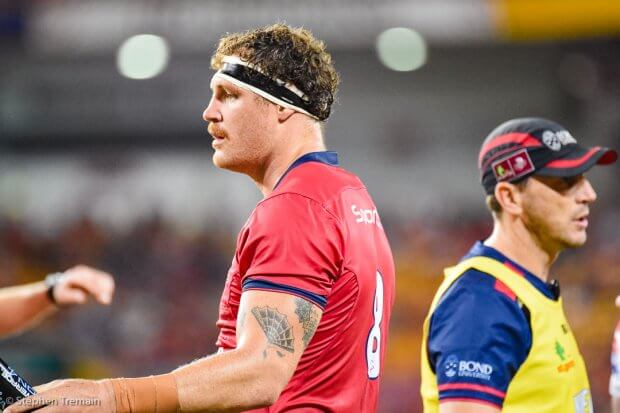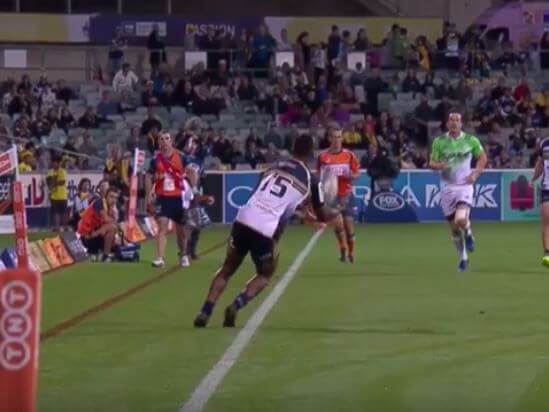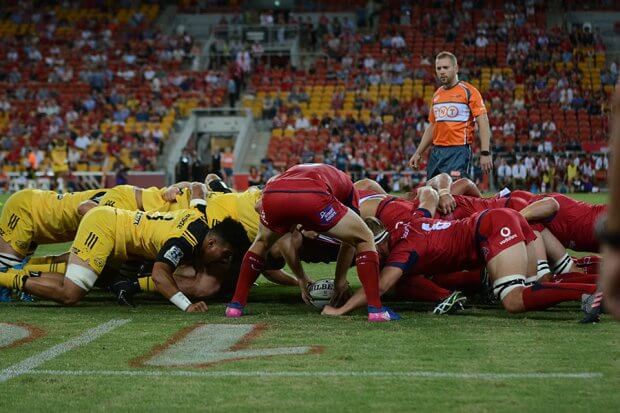Welcome to the Tuesday Top 5! Wow, what a bummer of a weekend for Aussie Teams. The Report Card might not be very nice this week. Lots of Bad and Ugly, but we still found some Good. Plus we look at a few things that are having a big impact, not only on the way the game is being played and officiated, but also how it is being viewed by fans.
Report Card
Sigh. I’m not really enjoying writing this one this week. I kind of want to give the Brumbies an A for being the only team not to lose to a Kiwi team. But then I’d have to mark them down for this – “The boys out wide haven’t seen too much ball at the moment, but that has been because of conditions,” said inside centre Kyle Godwin. Apparently the non-wet, and unpleasantly dry sunny or fine conditions that they have played in in every round seem to be causing difficulties.
Rebels: E After giving us all hope with their performance against the Chiefs, and again last week with their first half performance, we were brought back down this week. They looked tired and to be honest there wasn’t a whole lot to like about their performance. English (despite throwing a terrible intercept pass) and Hodge tried their best, but it just isn’t good enough from the Rebels right now. Like many are saying, they looked lost.
Force: C They were at times dominant but didn’t really take advantage of their opportunities. They put in a good showing against the Blues and were definitely threatening at times. Their finishing again let them down.
Reds: B- They were right in the match until the last 10 minutes. They scored 2 great tries, showing they are capable of offloading and running in support but other than the 2 glimpses in the first half they were pretty restricted. Higgers was back to his threatening best which, depending on Cheika of course, could be a good thing for the Wallabies.
Waratahs: C The same thing is being said repeatedly about the Waratahs … they looked tired. So tired that at times they were struggling to keep up. Maybe their SA trip took more out of them than we thought, but they only have 5 days to wake up before they take on the Canes in Wellington. They looked good in parts and it’s good to see the likes of Mason and Gordon really stepping up in tough circumstances. Something really has to be done about their defence though, simply too many missed tackles.
The Good, The Bad and The Ugly
The Good It was good to see Amy Perrett again take up the flag as AR during the Reds v Hurricanes match. Plus last week she was named as one of the 9 referees for the Women’s World Cup, which will be held in Ireland from the 9th -26th of August.
The Bad The whole of Round 6 for the Australian teams. 4 matches against NZ teams, 4 comprehensive (on the scoreboard) losses. The Reds and Tahs final score lines didn’t really reflect how close the games were, but realistically neither team looked like they were going to get the win.
The Ugly Look, I don’t want to bang on about how terrible Australian rugby is at the moment. We all know it, it’s in the media every day. But you have to admit, the SR table at the moment looks very ugly for our teams and Rugby in this country. How about we just keep an eye on our conference table from now on … ignore the one showing all 18 teams until we need to know who the Aussie team that makes the finals will play. It’s just plain depressing to look at.
Declining interest … Let’s postulate about why
Yep. It’s true. People are turning away from rugby. Lower crowds, less viewers … but why?
Well I guess the obvious one to say here is that fans like to see their teams win. When a team is winning, crowds are bigger. Not only are the Australian teams not winning at the moment, they (with the rare exception) are playing terribly. Tired, little to no defence, some sparks in attack but usually more dropped balls than scoring chances. Fans simply do not want to see this. We are getting sick of it.
But perhaps there are other, less obvious reasons.
It’s hard enough for fans to keep up to date with all the new variations (some are simple, head shots = bad, player in air = protected) but there are some subtle ones that the average joe supporter might not even be aware of. And judging by some games I’m not even sure the players remember them all.
Take the round 5 Brumbies v Highlanders match for example, when Aidan Toua appeared to catch the ball out of bounds after it was kicked by the Highlanders from outside their 22. I was at the match screaming along with the crowd about how wrong the call was. But when I looked it up, the ref was (said through gritted teeth) correct. It’s all here, in Law 19.
In the past, all a player had to do to make sure the ball was out was to have one or both feet in touch when they caught the ball. The ball was automatically seen as being out by the kicking team and the receiving team would get the line-out. During this match we saw Aiden Toua with both feet firmly planted outside the field of play, take the ball on the full. Everyone, including the commentators believed that it should have been ruled out on the full. But looking at the replay, the ball was still infield when he caught it, not having crossed the plane of touch. Therefore, he was deemed to have taken the ball out. AR made the right call according to the rules.
So we have to ask, was Toua 100% certain the ball had gone out (judging by the way he reached for it I would say probably not) or did he go with instinct, which would have come from years of playing under the previous law, and simply forget it had changed? Last year it would have been a Brumbies line-out from where the ball was kicked. This year a Highlanders line-out from where it was caught. Confusing much for fans?
Are these types of situations helping to turn people away from Rugby? When I got home I looked up the laws and watched a replay carefully to see. But I don’t think your everyday supporter would do that, they just see it as a call they don’t understand that went against their team and left them confused and upset. When the intricacies of the game change like this it really makes it hard for fans to understand what’s happening.
Refereeing the game or the replay?
Last season saw hurried conversions to avoid referees watching replays that could lead to disallowed tries – usually after seeing a replay on the big screen. This also was a case of the host broadcaster playing a part in the scenarios, with particular replays to show and/or focussing on suspect parts of the play when replaying to the big screen.
Now let me say right off the bat. I am all for the correct decision being made and the use of technology where it doesn’t unnecessarily interrupt or delay the game. Protocols and processes have been implemented to ensure that there is clarity and a consistency in the use of the technology and ensure teams are neither advantaged or disadvantaged by the use of the technology.
But have some referees fallen in to the trap of becoming technology dependant and refereeing the replay not the actual game? The Reds v Canes game that Angus Gardner was in charge of highlighted a concerning refereeing issue. A number of the tries on the night were referred up to the TMO. This is not that unusual until you consider that on the majority of occasions Angus’s on field decision was wrong. Which begs the question, with 3 of them how did the referee get it wrong in the first place, and what made him change his mind? Unusually the host broadcasters did not show him requesting the TMO review directly after the try was scored. Not being live at the ground, I am unsure how the TMO was involved and if he used the new TMO review protocols or was it ad-hoc involvement from the TMO. Or did he watch a replay on the big screen and realise he had made and error compliments of the home broadcaster drawing it to his attention? I understand that referees make mistakes but you have to question those significant errors and the reliance on replays and the TMO.
It’s worrying that he relied so heavily on replays to correct his decision. That can’t happen in general play, he can’t call a ball back because there happened to be a replay of a forward pass that happened 10 phases ago, so referees really need to be certain of their calls. Was he?
Does it suggest that there is simply too much for the referee/AR’s to be watching at once? Take for example the 2nd no try. In the replay it was fairly clear that Mark Abbott had put his foot on the touch line. It also showed that Nick Berry was right on the spot in a perfect position to see that. But a still shot at the time showed that he wasn’t even looking at the line, he was watching the player and looked to be looking ahead to make sure he was going to ground the ball correctly. If he had been watching the line it would have been called back immediately.
Likewise, when TJ took the quick tap that wasn’t. Angus Gardner had to make sure that he tapped it correctly, from the correct spot and that all of the Reds players were onside. All at the same time. He missed at least one of those things, a pretty important one actually, and awarded a try that shouldn’t have been awarded.
From a fans point of view this a real issue with the game. Poor refereeing will always have an impact on viewers. Part of the reason the TMO protocols were introduced this year was to speed up the review process and be less dependent on the TMO needing to make decisions.
Stoppages, stoppages and more stoppages
The refereeing issues and TMO replays got me to wondering how much time is being wasted with all the replays etc. So I sat down and looked at the length of each half of the games featuring Aussie teams over the last two weeks and was shocked at the results. I was expecting that the length of the game would be blowing out, but it’s not.
Apart from 2 matches in round 5 where the 2nd half went for over 50 minutes (Brumbies v Highlanders, 53 minutes and Jaguares v Reds, 55 minutes), on average each half was running approximately 47 minutes. That’s not really too much longer when you consider injuries, TMO referrals and substitutes all have the clock stopped.
So let’s look at the round 6 clash between the Reds and the Hurricanes. The 2nd half of the match was fast paced, frenetic with lots of ball in play, multiple phase play etc, right? It was actually one of the more interesting games to watch this weekend. So let’s look at the times for just the 2nd half.
From whistle to whistle the half ran for approximately 47 minutes. When the final whistle blew the clock read 80:05, so just an extra 5 seconds of game time. So there was approximately 7 minutes worth of stoppages, mostly made up of TMO referrals, substitutions and injury breaks. Now here’s the kicker. During that 40 minutes and 5 seconds there were scrums, resets, lineouts, penalties and conversions. During all of which the clock keeps running. In fact there was 20 minutes and 5 seconds where the ball was NOT in play. That’s 20 minutes of the players standing in huddles talking, getting ready for scrums, walking to the lineout or just getting back on side.
Now I’m not stupid, I know that there’s no way the ball is in play for the whole 40 minutes. But only 20 minutes? That’s one quarter of the game where there is effectively nothing happening. The ball was not in play for longer than it was in play. 33 times in the 2nd half of this match the ball was not in play. Close to once per minute. On only 12 of those occasions was the stoppage less than 30 seconds. 5 of the stoppages were over 1 minute long. Assuming the 1st half had a similar number of stoppages there’s potentially 50% of the match where the ball isn’t in play.
For rugby fans this may not impact the enjoyment of watching the match, especially when it’s a tight encounter. But for a casual observer, particularly in a more error ridden match, I imagine they might find it all a bit tedious. I’d be interested to see how long the ball was out of play in the 2nd half of the Crusaders v Force match from round 5 when even the commentators were getting tired of the scrum resets …




